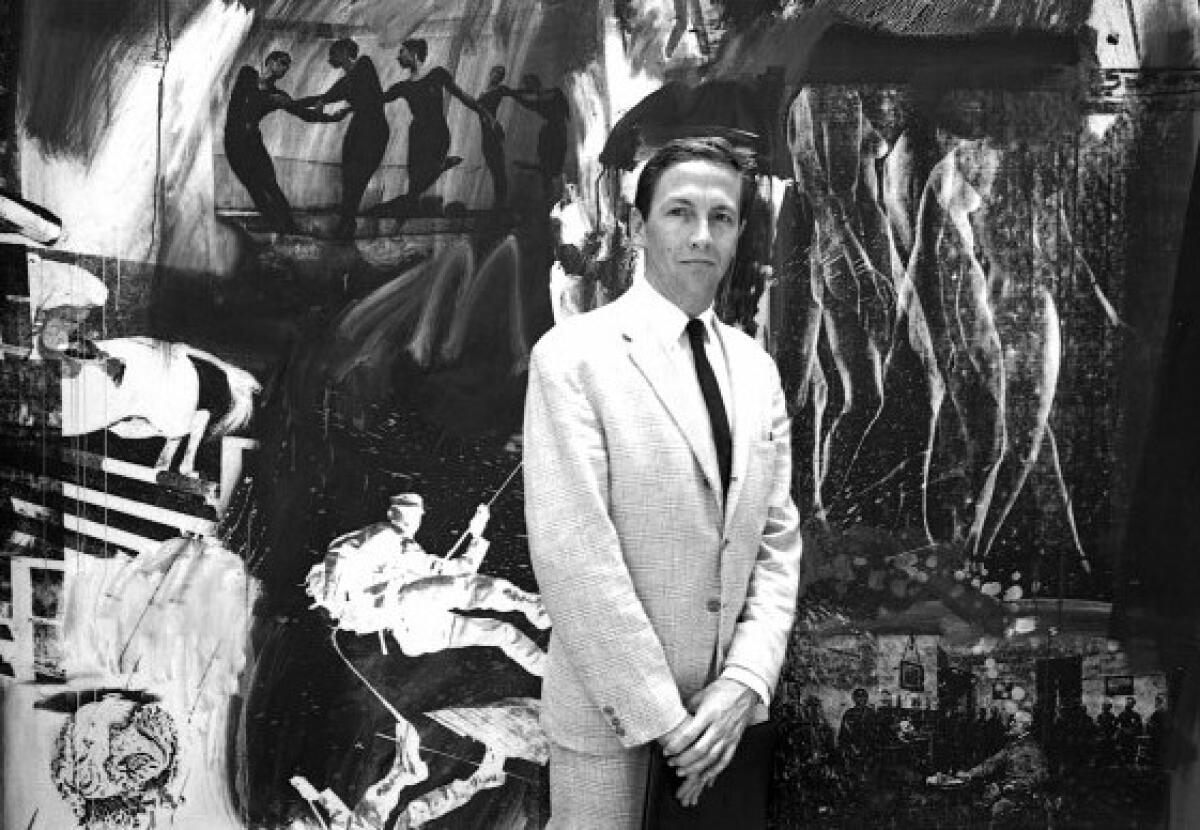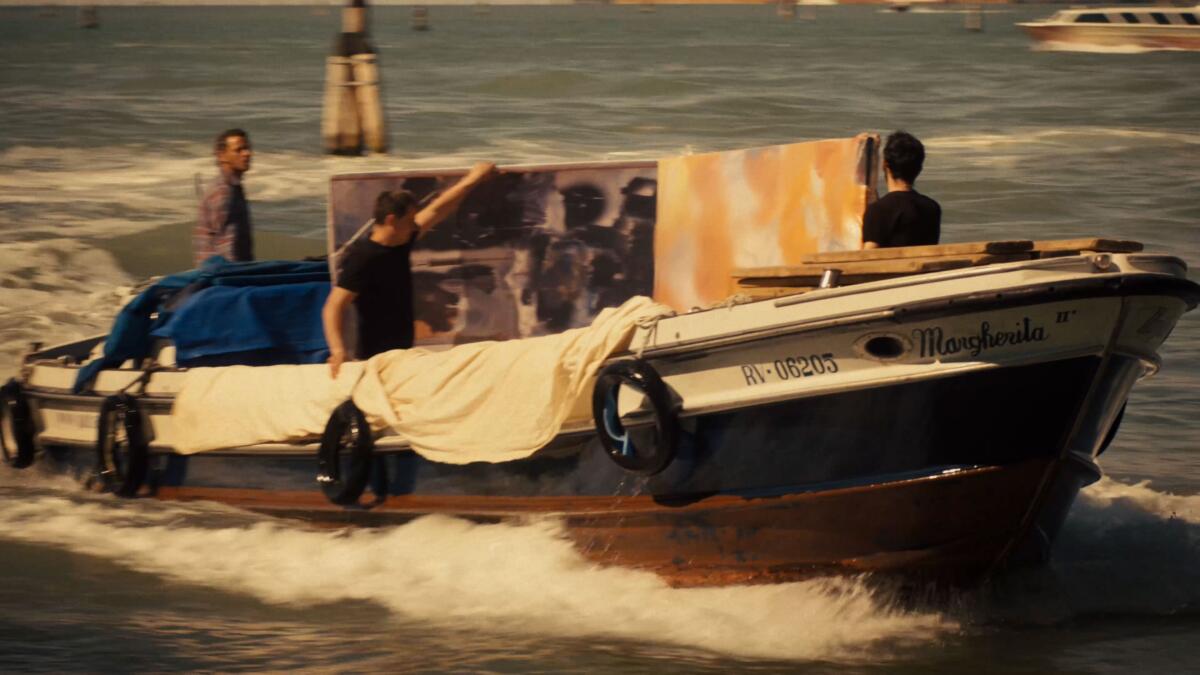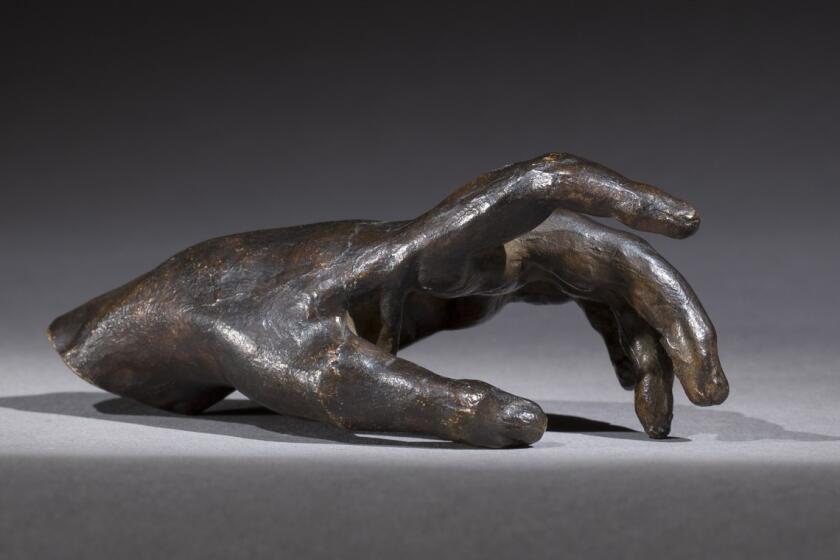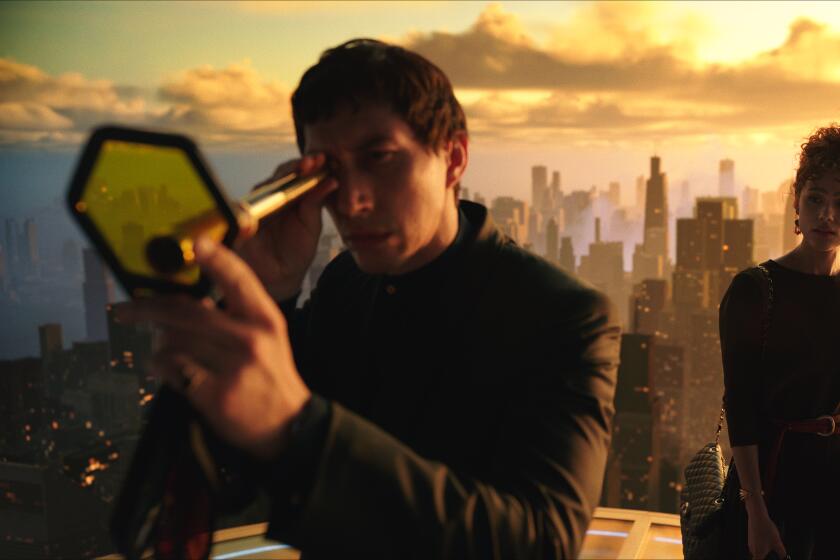Review: Was the 1964 Venice Biennale rigged? The documentary ‘Taking Venice’ looks at conspiratorial claims

- Share via
The Venice Biennale may have lost much of its singular luster, now that hundreds of periodic surveys of new international art have joined the roster of what was the first — and, for decades after its 1895 founding, one of the few — of its kind. An artist can still get an important career boost from successful participation in the venerable and widely publicized Italian exhibition, currently in its 60th outing. (It remains on view at the city’s Giardini and Arsenale through Nov. 24.) But no one anymore expects the extravaganza to dramatically alter larger perceptions of art, the way it once did — perhaps most notably in 1964.
That was the year Robert Rauschenberg, then 38, became the first American artist to win the coveted Grand Prize for Painting, now called the Golden Lion. At the announcement, all hell broke loose. “Treason in Venice,” yelled one newspaper’s overheated headline.
The unprecedented award to an American artist who, a decade earlier, portended the controversial Pop Art genre cresting sealed a slow but steady shift underway since the end of World War II: New York officially bumped Paris from the top slot of cultural taste makers. The critical press in Europe, especially France, framed the story as a scandal. Surely skulduggery was at work.
That’s a frame of reference that guides “Taking Venice,” a bumpy new documentary directed by filmmaker and longtime New York art writer Amei Wallach. “Taking Venice” doesn’t take a position on whether dishonest mischief sullied the jury’s process of choosing Rauschenberg, although it does leave the appropriate sense that the artist easily measured up to the honor. (The other Biennale prizes went to Hungarian-Swiss sculptor Zoltan Kemeny, German draftsman Joseph Fassbender, Italian etcher Angelo Savelli and sculptors Andrea Cascella and Arnaldo Pomodoro — all respectable at best.) Yet, the framing also gets in the way of an otherwise well-informed view of a significant historical moment.
Sculptor Camille Claudel was more than a tragic figure. Her art influenced her titanic mentor, Auguste Rodin. A smart L.A. exhibition explains how
Conspiracy theories drove the original “scandal” story line, but the maneuvering to get the prize was actually business as usual. When something unexpected and dramatic occurs, like the Biennale’s American “first,” the creation of a conspiracy theory is one way to make at least a semblance of sense out of a seemingly inexplicable event. An irrational illusion of rational explanation, it provides a veil of stability in a topsy-turvy world.
Rauschenberg’s anointing was all too much for those who simply could not fathom that Paris — fountainhead of Picasso, Matisse, Miro, Brancusi and even Duchamp — had been toppled on the international cultural stage by a supposedly vulgar, Texas-born parvenu who silkscreened commercial images of President Kennedy and phallic rocket ships onto canvas and famously slathered paint on the nose of a stuffed goat (“Monogram,” 1955-59). A cultural crime had occurred. Guilt needed to be ascribed. Conspiracies mushroomed.
The story of what actually went on in the run-up to the prize is certainly complicated. For clarity, Wallach smartly crafts the film around four primary players, starting of course with “The Artist.” A thumbnail of his artistic bio unfolds.
Then there’s “The Dealer,” Leo Castelli, a suave and affable Italian expatriate to New York who engineered the rise of American Pop, including Rauschenberg, to commercial success. Raised in Trieste, across the Adriatic from Venice, he also understood the European fascination with the democratic capitalism represented by Pop’s soup cans, Hollywood celebrity and comic strips, as postwar rebuilding relied on American commercial goods. That the gallery operated by Ileana Sonnabend, Castelli’s Romanian ex-wife, was located in Paris didn’t hurt.
“The Insider” is Alice Denney, a Washington, D.C., art maven, wife of a State Department lawyer, and friend of the Kennedy family. (Denney died in November at 101.) For the first time, the United States government was helping sponsor the privately operated American Pavilion in Venice, as foreign governments always did theirs. When a boost was needed, like getting a military cargo plane to transport large-scale art across the Atlantic, Denney was on hand to push the necessary buttons.
Finally, “The Commissioner” organizing the American presence at the Biennale was Alan Solomon. He had turned Manhattan’s Jewish Museum into an avant-garde hothouse during his brief tenure as director, from 1962 to 1964, including with solo shows of Rauschenberg and his former lover, Jasper Johns. Solomon, not well-known today, was a Harvard-educated bon vivant known for his erudition in new art’s European history. In 1970, when he died of a heart attack at 49, just a few months after the opening of his last exhibition, “Painting in New York: 1944–1969,” at the Pasadena Art Museum, he was chairman of the adventurous new art department at UC Irvine.

The artist, the dealer, the insider, the commissioner — the complexities of getting the Venice presentation together are clearly laid out in the film. Appropriate nods are also given to familiar elements of cultural context, which contributed to the ultimate commotion.
The list is long. Rauschenberg’s controversial work had been categorized as Dada-inspired “anti-art.” The sponsoring U.S. government had well-established Cold War propaganda interests. Solomon’s show was too large for the relatively small American Pavilion, so a rules-busting annex was pressed into service in the empty former U.S. consulate next to Peggy Guggenheim’s palazzo-museum on the Grand Canal, adding to a sense of superpower pushiness. International resistance was greeting President Lyndon B. Johnson’s expansion of U.S. military presence in Indochina, which chipped away at global sympathy in the wake of the Kennedy assassination. Sam Hunter, an influential American art historian, was an eleventh-hour addition to the prize jury. At Venice’s legendary Teatro La Fenice, a last-minute all-American avant-garde dance performance by Merce Cunningham and John Cage with sets by Rauschenberg was a wild success. And much more.
Still, all of that was merely packing the dynamite. For an explosion, the fuse needed lighting. It was Solomon who brought the matches.
The Grand Prize selection was always the result of obscure dealings among influential partisans in smoke-filled backrooms, but Solomon drew an aggressive public line in the sand. As the deadlocked jury deliberated privately, he held a press conference and distributed an official statement. Headed “Americans in Venice” — printed all in caps — the sheet featured a tourist photo of the ancient Rialto Bridge spanning the Grand Canal juxtaposed with a three-tiered painting of an American flag by Johns.
In case the pictorial story of crossing a Rubicon was not enough, the blunt text declared, “The fact that the world art center has shifted from Paris to New York is acknowledged on every hand.” Venice’s celebrated Biennale, Solomon implied, risked irrelevance.
Starring Adam Driver, Giancarlo Esposito and an unhinged Aubrey Plaza, the storied director’s latest passion project brings the heat of an event film to Cannes.
Rauschenberg’s ultimate selection certainly gave everyone something to talk about — and they did, often loudly. (The pick sowed “the seeds of a new fascism” in the opinion of one particularly outlandish review.) The artist himself was happy but anxious, soon deciding to destroy all the silk screens he had used to make his exhibited paintings so he couldn’t repeat himself. In retrospect, he observed of the new career pressures, “There were moments when I thought things would have been much better if I hadn’t been so lucky.”
But a conspiracy? Despite the film’s annoying musical score (by CheeWei Tay), which pulses furiously like it’s a B-movie melodrama, that’s nowhere to be found. The horse-trading vote feels more like the norm, which is interesting enough. Thanks to the internet and social media today, conspiracy theories have become epidemic, since the multitudes can now hear the same fantastical whispers of a rigged game en masse. (For details, Google “Jan. 6, 2021.”) Sixty years on, their ubiquity makes “Taking Venice” seem rather quaint.
Much of the story’s factual scaffolding was plainly provided by “The Great Migrator: Robert Rauschenberg and the Global Rise of American Art,” the critically acclaimed 2010 book by art historian Hiroko Ikegami. (She appears in the film to offer welcome narrative detail.) Sometimes the story wanders off into lengthy but unnecessary asides, including staged re-creations of the lightly comic difficulty in moving (faux) Rauschenberg paintings on water taxis, Sonnabend’s dealer adventures in Paris and the American Pavilion shows held in 2017, 2019 and 2022. At 98 minutes, “Taking Venice” is a half-hour too long.
Still, the story embedded within it is an important one. A historic shift did occur. The account is well-told and worth knowing, even without conspiratorial murmurs.
A sneak-peek of the film is scheduled for Thursday at the UCLA Hammer Museum, followed by a Q&A with the director. Wallach will do the same on Friday and Saturday nights at the Laemmle Royal in West L.A., where the film opens for a one-week run.
'Taking Venice'
Not rated
Running time: 1 hour, 38 minutes
Playing: Laemmle Royal, Santa Monica; Laemmle Town Center 5, Encino
More to Read
The biggest entertainment stories
Get our big stories about Hollywood, film, television, music, arts, culture and more right in your inbox as soon as they publish.
You may occasionally receive promotional content from the Los Angeles Times.













